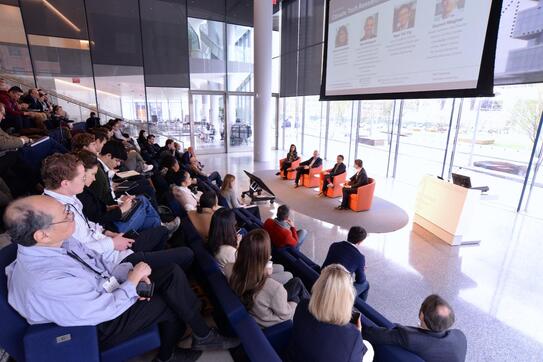By now, over half of the world’s largest 2,000 publicly listed companies have published net-zero carbon emissions pledges, according to Net Zero Tracker. As such, a new market is coalescing in real time to enable these companies to stand by their public declarations. A new market brings formidable opportunities — and, of course, equally formidable growing pains.
Climate tech startup Heirloom Carbon offers one illustration of the ways in which net-zero goals are driving a need for a wide variety of increasingly sophisticated climate tech and a market to contain them. At Columbia Business School’s recent 2024 Climate Business & Investment Conference — hosted by the Tamer Institute for Social Enterprise and Climate Change, Columbia Technology Ventures, and Columbia Climate School — Heirloom’s Nishad Pai, head of business development and partnerships, explained how net-zero pledges are creating a demand for Heirloom’s high-durability carbon-removal services.
Startups like Heirloom are able to package the environmental benefits of their carbon dioxide removal as credits, he said, which they can sell to companies seeking to abate their emissions. “This generates revenue, it sends demand signals to the market, and it allows Heirloom to raise venture capital and project capital,” Pai explained.
To date, Heirloom’s biggest deal is with Microsoft, which has announced a goal to achieve net zero by 2030 while also removing, by 2050, all emissions produced by the technology behemoth since 1975. Heirloom signed on to remove up to 315,000 metric tons of carbon dioxide on Microsoft’s behalf over roughly the next decade.
“Many other companies have published net-zero goals, and there’s a general acknowledgement that we’ll see supply constraints for high-durability carbon-dioxide removal by 2035 and beyond,” Pai noted, especially as carbon markets shift from voluntary to legally enforced, as Heirloom predicts will become common over the next seven to 10 years. “That means companies are willing to pay higher prices for lower volumes today, for the promise of access to higher volumes at lower prices down the road.”
These types of considerations offer a glimpse inside the burgeoning climate markets of the future — and the emerging climate tech that will help support them. Such discussions were also the focus of the day at the CBS climate conference, whose theme this year was Climate Tech for Net Zero.

Speakers of note included General Motors CEO Mary Barra, who in a session moderated by The Economist’s Vijay Vaitheeswaran shared how the automaker is tackling the EV revolution. Another key speaker, Bernd Heid, senior partner at McKinsey, noted that the market for climate technology currently stands at nearly $1 trillion and roughly doubles every decade.
“Here we have a $4 trillion opportunity in the equipment value chain — 3.3 percent of global GDP. What climate technology can contribute is roughly equivalent to today’s global auto industry,” he added.
This growing market is being driven by established industry leaders, fledgling startups, investors, and researchers and inventors — and each of these groups were represented at the conference to discuss the market’s progress and necessary course corrections. From their conversations emerged three central takeaways:
1. The world-saving climate technologies we need already exist — now, they need to be scaled.
Heid shared research highlighting 12 key climate technologies, emphasizing that, collectively, they account for 90 percent of the decarbonization necessary to stave off climate disaster.
“We know these technologies; it’s not that we have to invent new technologies,” he said. “The problem is that they are not scaled yet.”
Of the 12 climate technologies Heid mentioned, only 10 percent of them are globally deployed (those being certain solar and wind technologies). The rest are simply not yet “in the money” — that is, not yet able to sustain profitable businesses.
What has been the defining difference between the technologies that have reached the stage of global deployment and a sound business case? It comes down to scaling, Heid said: Deploying a technology at larger scale brings down its costs.
Heid called this phenomenon the Moore’s Law of climate technology: he and his colleagues have found that a climate technology’s scale-up of 100 times drives a cost reduction of about 70 percent — and this holds true across technologies and stages of innovation.
He argued that the challenge before us now concerns not the discovery of new tech inventions but the piecing together of new manufacturing-engineering solutions: How can, say, battery factories be built at scale to significantly lower costs?
2. Government-led market mechanisms will be necessary.
Heid shared a sobering projection: Even when he crunched the numbers looking out as far ahead as 2030, solar and wind remain the only economically viable climate technologies.
The upshot, he said, is that climate tech-based businesses and initiatives need the government’s backing. “That could be a carbon tax; it could be incentives,” Heid noted. “But there needs to be something that helps these technologies get ‘into the money.’”
When McKinsey performed the same projections adding in a carbon price of $100 per ton, 15 of its key 35 emerging climate technologies immediately became profitable.
“Decarbonization doesn’t come for free,” Heid said. “If we want to decarbonize, someone has to pick up the bill for it. That’s either us, as consumers, or it’s public money, or it needs to be companies that take a risk now with no positive business case.”
This general sentiment was echoed by Dan Steingart, professor of chemical engineering at Columbia Engineering and co-director of the Columbia Electrochemical Energy Center. He pointed out, however, that in some sectors of climate tech, even a price on carbon is unlikely to be a strong enough intervention.
When it comes to decarbonizing the steel sector, he said, “even a magical global carbon price won’t have much of an impact, because most steel is made in China and India, and it’s going to be difficult to make them price this in.”
Instead, what’s needed in that sector is a “massive amount of direct government subsidy to companies,” Steingart said, to encourage them to devote expensive research and development resources to solving the thorny question of how to produce lower-emission steel.
Shiho Kawashima, associate professor of civil engineering and engineering mechanics at Columbia Engineering, pointed out that new government policies are coming online all the time in the United States — and they’re helping. For example, New York state began requiring its contractors to adhere to lower-carbon policies in the procurement of concrete (Kawashima’s area of expertise) starting at the beginning of 2024.
“That is going to force industry change,” Kawashima said.
3. Climate solutions will emerge in iterative ways, which means challenges (especially in financing) must be confronted now.
McKinsey’s Heid underscored the point that the world doesn’t have time to wait until climate tech’s cost curve starts to lower on its own.
“The costs do not come down; instead, there’s a learning curve,” he said. “If you want to deploy a 2-gigawatt hydrogen project, you’d better start with 200 megawatts. Then, take the learning to the next iteration, scale, and deploy. You have to do that in cycles.”
One area in which this trial and error needs to be happening more aggressively, Heid noted, is in green financing: “We need to be smarter about connecting public-private partnerships, public money with private money. This all needs to work together. It will not work to just wait until we have the business cases that deliver the returns that we expect from normal businesses.”
Malika Anand, head of impact and ESG at Catalyst Fund, pointed out that some sub sectors within climate tech are especially overlooked — for instance, she said, climate resilience and adaptation technology.
Through her work at Catalyst, an early-stage venture capital fund and accelerator that backs tech-enabled startups offering resilience and adaptation solutions in Africa, Anand has seen that “not nearly enough attention and not nearly enough dollars are going to resilience and adaptation.”
For one thing, she said, this is an area of climate tech that is not as “plug and play” as other climate tech solutions. Context, geography, and populations all matter in determining the best-fit solutions. Another challenge is that while many venture vehicles require a 10-year time horizon, these technologies require up to 50-year time horizons.
“I really don’t think we’re there yet on the financing side, in terms of building the right kinds of capital structures for getting these solutions over the line,” Anand said.
The resilience and adaptation technologies that she sees as most necessary to maintaining healthy lives in Africa’s fast-growing urban centers — technologies in areas such as housing, transport, cooling, and air quality — are still woefully overlooked by investors, she added.
“Seventy percent of the population in sub-Saharan Africa today is under 30 years old, and what that means is there’s an enormous number of people who are already facing the threat and impact of climate change and who need to prepare and manage for future impacts,” Anand said. “And they’re also thinking about how to leapfrog all of the mistakes that we in the developed world have made in achieving economic development and quality of life. All of that is the realm of resilience and adaptation.”
Watch more videos from the conference here.
